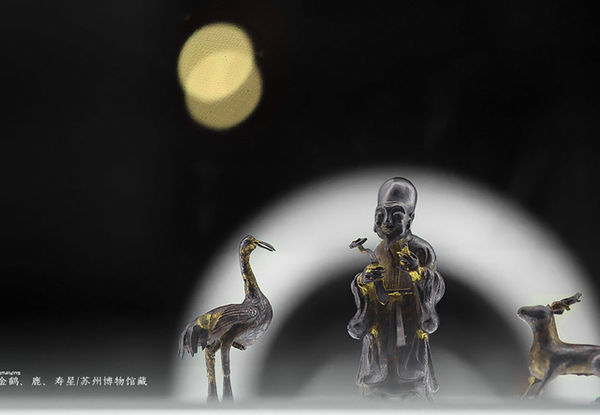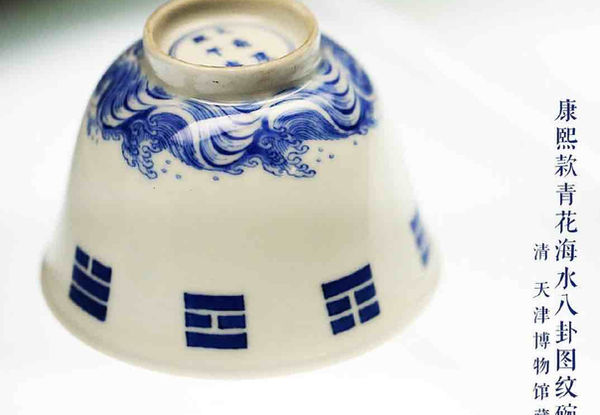Chinese Patterns — Ultimate Introduction to Origin, History, Meaning, Culture, and Utilization
Pursuing beauty and good luck has been an essential part of people's lives, from neolithic tribes to modern society.
Chinese patterns embody traditional culture and aesthetics in daily utensils, ritual wares, clothes, and jewelry.
Historically, patterns and colors were quite strict, as some of them would exclusively be used by certain groups based on social status, occupation, gender, age, etc.
Therefore, every Chinese pattern has a unique origin, story, and meaning.
Today, however, with restrictions lifted away, popular patterns inherited their traditional meanings as brilliant representatives of cultural legacy and beautiful wishes for auspicious lives.
All Photos on This Page Are From Dongmaiying Unless Noted

Jade Article of Liangzhu Culture (around 3300 BC — 2000 BC) with Decorative Patterns — Zhejiang Museum
12 Imperial Patterns on Emperors' Robes
Originating in ancient history during the reign of King Shun, documented and formed in the Zhou Dynasty (1046 BC — 256 BC), 12 patterns were used for emperors' imperial robes.
The colors and positions of those patterns changed slightly in different dynasties; however, the content and essence had been well applied and inherited in millennium years.
Most importantly, these patterns were rigorous: Emperors of China (some dynasties included honorable prime ministers) would use 12 patterns; the lower social status, the fewer patterns one could wear.
Sun (Ri)

Moon (Yue)

Star (Xing Cheng)

Meaning people wearing these patterns are responsible for illuminating and enlightening all humankind.
Mountain (Qun Shan): Firm, Persistent, Steady.

Dragon (Loong): Mysterious, Changeable, Unpredictable.

Fire (Huo): Bright and Promising.

Colorful Flower and Bird (Hua Chong): Intelligent, Write Beautiful Articles.

Algae (Zao): Emerges from the filth and stays unstained, meaning characteristic of pure and noble.

Rice (Fen Mi): To Provide and Nurture.

Axe (Fu): To cut off negative aspects and stay resolute and decisive.

A Special Ancient Embroidery (Fu): It looks like two bows back against each other, which means smart perceive, back away from evil, and face toward benign.

Tiger and Monkey (Zong Yi): A pair of ancient wine vessels in sacrifice ceremonies, meaning respect for the ancestors. The tiger represents power and dignity; the long tail monkey symbolizes wisdom, loyalty, and filial piety.


Hongzhi Emperor in Imperial Robe with the 12 Patterns, Painted By Court Artist of the Ming Dynasty — Taipei Palace Museum
Patterns from Nature
Since the Neolithic era, people have begun to carve or paint patterns of natural elements to show respect and worship to grand nature, pray for blessings, or use them as decorations.
Cloud, thunder, vortex, mountain, and water wave and their evolved patterns have been frequently used, till today, as representatives of auspiciousness, promotion, happiness, wealth, etc.
The 3 Frequently Used Animals in History — Fish, Dragon, and Bird.
Among all animal patterns, fish, bird, and dragon are the three most ancient and frequently used in history and today.
Fish
In the Neolithic era, when primitive tribes lived and thrived near rivers, productive and vigorous fishes were their essential food resources.

Pottery of Yangshao Culture (5000 BC — 3000 BC) Decorated with Fish Patterns — Taipei Museum of History
Gradually, fishes became totems of some tribes and were apotheosized as animals that could communicate and connect the worlds of deities and humans.
Those well-cultivated ones would transform into dragons and fly to heaven.
Therefore, fish has been representative of success, productivity, strength, luck, and wealth and has been widely used in different aspects of Chinese culture throughout history.
The great philosopher Confucius (about 551 BC — 479 BC) named his only son "Li" (meaning carp) and with courtesy name Boyu (meaning fish).
Moreover, many fish patterns were carved or painted in cultural relics from different dynasties.

Silver Gilt Basin of the Song Dynasty (960 — 1279) with Fish Patterns — Zhenjiang Museum
Dragon
Dragon or Loong is a mythical creature that has been respected as the totem of Chinese people and used to be the representative of emperors and their paramount authority.
Dragons are strong, powerful, righteous, and responsible and have been exclusively used by royals in many dynasties.
Large numbers of different types of dragon patterns have developed through time. However, their popularity and auspicious meanings have been inherited well for thousands of years.

Gold Kettle of the Ming Dynasty (1368 — 1644) Carved with Dragon Patterns — Capital Museum
Phoenix Bird Fenghuang
A mythical bird named Xuanniao was worshiped as the ancestor of a clan whose descendants built the Shang Dynasty (1600 BC — 1046 BC).
Therefore, this mythical bird, in some versions later evolved as Fenghuang or Phoenix, was the totem of the Shang Empire.

Phoenix Shape Jade of Queen Fu Hao of the of the Shang Dynasty (1600 BC — 1046 BC) — National Museum of China
The King of Birds Phoenix, in Chinese named Fengniao or Fenghuang, since then, has been the representative of beauty, luck, honor, power, empress, royal women, and brides.

Phoenix Shape Gold Decoration of the Ming Dynasty (1368 — 1644) — Nanjing Museum
Mythical Creatures from Ancient Legends
Inferior to the paramount dragons and phoenixes, many other auspicious and powerful mythical animals have been widely used in Chinese patterns.
Click to read more about Mythical Creatures in Chinese Mythology
Animals in Ancient Chinese Astrology
In ancient Chinese astrology, stars in the sky are divided into groups based on their locations: Three Enclosures, Four Symbols, and Twenty-eight Lunar Mansions.
Combined with Yin Yang and Five Elements, every symbol and mansion has assigned a beautiful name, a deity, and an auspicious animal to guard.
Click to read more about Ancient Chinese Astrology and Constellation

The Earliest Artifact (Lacquer Suitcase) with the Entire Twenty-eight Lunar Mansions' names, Unearthed from Tomb of Marquis Yi of Zeng (about 477 BC — 433 BC) — Hubei Museum
Among those astrological animals, the four mythical creatures guarding the Four Symbols and representing the four seasons are the most popular:
The Azure Dragon in the East represents spring, the Vermillion Bird in the South represents summer, the White Tiger in the West represents autumn, and the Black Tortoise in the North represents winter.

Azure Dragon

Vermillion Bird

White Tiger

Black Tortoise
Eaves Tiles of the Han Dynasty (202 BC — 220 AD) — Shanghai Museum
Zodiac Animals
Chinese Zodiac Signs formed no later than the Warring States Period (403 BC — 221 BC) and include 12 animals representing the 12 Earthly Branches or Terrestrial Branches to record years, months, and hours.
Based on one's birthday, every person has a zodiac animal and some beneficial or incompatible signs.
Hence, these 12 zodiac animals, including Rat, Ox, Tiger, Rabbit, Dragon, Snake, Horse, Goat, Monkey, Rooster, Dog, and Pig, have been popular elements in Chinese patterns.

12 Zodiac Animals Carved on Copper Mirror of the Tang Dynasty (618 — 907) — Luoyang Museum
Lucky Animals with Auspicious Meanings
Besides mythical, astrological, and zodiac series, there are some other lucky animals that civilians frequently use as traditional Chinese patterns.
-
Red-crowned Crane — Symbol of longevity and high-ranking officials.
-
Deer — Deer was believed to be the ride of a human when someone became immortal; it also has the same pronunciation of "Lu" as "happiness" in Chinese.
-
Elephant — The elephant in Chinese is Xiang, which has a similar sound to the auspicious and powerful chancellor.
-
Cicada — Cicadas live in high places and eat plant sap, and have been used as a popular pattern to represent nobility, purity, and clean diets.
-
Mandarin Duck — Always show up in pairs, Mandarin Duck or Yuanyang has been representative of a sweet couple and eternal love in Chinese culture for millennia.
-
Magpie — Believed the bird that can report lucky messages, whose sounds are pretty welcome in China.
Symbolic Flora — Twined Branches and Elegant Flowers
Flora is an essential section of traditional Chinese patterns, including Auspicious Flowers that represent 12 months in the Chinese Calendar, plants with lucky pronunciations or meanings, and continuously twined branches and flowers that symbolize endless happiness and prosperity.
Auspicious Chinese Characters

Eaves Tiles of the Han Dynasty (202 BC — 220 AD) Decorated With Characters "Le Wei Yang", Meaning Eternal Happiness — Fujian Museum
Religious Patterns
In Taoism and Buddhism religion, magical implements used in practices (usually choosing eight objects as a group) are important Chinese patterns.
Food and Stylish Objects

Grain Patterns Decorated on Dragon Shaped Jade of the Warring States Period (403 BC — 221 BC) — Hubei Museum
Human Figures from Mythology, History, Literature, and Daily Lives

Silver Gilt Hairpin of the Song Dynasty (960 — 1279) Decorated with Figures of Happily Married Couples — Ningguo Museum (Photo by Dongmaiying)
Combination of Basic Patterns — Homophony and Meaning
Besides essential elements, combining different patterns based on meanings and pronunciations to form a new lucky picture has been a widely welcomed method.
Composed meaning, for example, the patterns of dragons, mountains, and waves together symbolize solid reigns.

Composed patterns of dragons, mountains, and waves on Imperial Fabric of the Ming Dynasty (1368 — 1644), Photo from Xiefangzhuren Dong Jin.
Composed homophony usually takes selected patterns' names to form a new lucky phrase.

Porcelain Bowl of the Ming Dynasty (1368 — 1644) with Patterns of Sparrow, Deer, Bee, and Monkey, Whose Pronunciations Homophonicly Represent Nobility and Wealth — Asian Art Museum of San Francisco
Hierarchical Clothing Patterns of Officials in History
During Emperor Wu Zetian's reign (690 — 705), officials started to embroider animal patterns on robes under the emperor's command.
Based on hierarchies, civil officials use birds, and military officials wear beast patterns.
After Ming Dynasty (1368 — 1644) was established, the founding emperor Zhu Yuanzhang officially set the utilization of animal patterns as a national rule, which was also followed by the subsequent Qing Dynasty (1636 — 1912).
Civil officials' animal patterns on clothes (or Buzi in Chinese) of the Qing Dynasty ranking from high to low:
Military officials' animal patterns on clothes (or Buzi in Chinese) of the Qing Dynasty ranking from high to low:
You Might Also Like:
Color Symbolism in Chinese Culture
Imagery in Ancient Chinese Poems — Expressing Emotions through Visible Objects
Chinese Symbols — Cultural Meanings and Aesthetic Values
Chinese Silk — Traditions, Utilizations, Fabrics, Embroideries, Products, and Art
Chinese Porcelain and Pottery — Art of Earth and Fire
Chinese Art — Aesthetic, Characteristic, and Form
Chinese Paintings — Tradition, Aesthetics, Poetic Beauty, and Artistic Conception
Chinese Calligraphy — Aesthetics of the Supreme Art of Ancient China
Chinese Numbers — History, Fun Facts, and Cultural Meanings
Chinese Costume and the Strict Hierarchy in the History
Chinese Emperors — Ultimate Introduction to Emperors of Ancient China
Empresses of China — Ultimate Introduction to Imperial Harems of Ancient China
Valuable Pieces of Jewelry and Their Historical, Cultural Meanings
Beautiful, Exquisite Traditional Chinese Hair Ornaments
Delicate Pendant Accessories in the History of China
Traditional Love Token — Representative of Romance and Affection
Chinese Jade — Origin, History, Meaning, Culture, and Utilization
Yin Yang and Taiji — Origin, Meaning, Symbol, and Utilization
Chinese Zodiac Signs — A Comprehensive Introduction
Chinese Astrology — Three Enclosures, Four Symbols, Twenty-eight Lunar Mansions
Traditional Handicrafts in Chinese Art
Chinese Architecture — Tradition, Characteristics, and Style
Traditional Chinese Instrument
Mysterious and Powerful Creatures in Chinese Legends
Chinese Dragon or Loong — History, Power, Utilization, and Culture
The Nine Sons of the Dragon — An Ultimate Guide



























